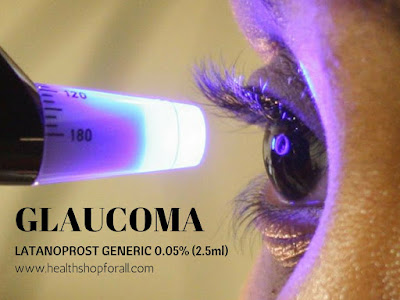Glaucoma is a condition of the eye characterised by irreversible vision loss of vision, the condition is usually caused by rising ocular pressure. This is one of the leading causes of vision loss and requires caution as it is hard to diagnose the disease in early days. There are various treatment options available for the management of Glaucoma, for open-angle glaucoma the most preferred early treatment option is
Latanoprost Ophthalmic solution 0.005 eye drops. The other available treatment options are listed under for your convenience.
Trabeculoplasty:
This is a surgery done on open-angle glaucoma patients. The eye surgeon makes use of a laser beam and corrects or opens up the drainage angle so that it works better. Due to this, the fluidity of Aqueous Humour is increased and the eye pressure is reduced. In Trabeculectomy, first a fold is created in the white part of the eye and then a small hole is made so that the drainage gets better.
Iridotomy:
Iridotomy is a laser operation done on people who are suffering from angle-closure glaucoma. The ophthalmologist makes a very small hole in the iris, which makes the fluid reach the drainage channel.
Surgery:
Also known as operating room surgery, this also aims at increasing the Aqueous Humour flow by creating a drainage channel.
Trabeculectomy:
Here, your eye surgeon will make a flap in sclera along with creating a pocket in the conjunctiva also known as filtration bleb. It is commonly not seen as it is hidden in the upper eyelid. The drainage of Aqueous humour will increase through the flap and into the bleb where the extra fluid is absorbed by the surrounding tissues.
Devices for Drainage:
Here, a tiny drainage tube is implanted in the eye which sends the fluid to a reservoir or collective area from where the fluid is absorbed into nearby blood vessels.
How can you assist in the treatment?
Glaucoma treatment is a team effort; you have to be equally involved with your doctor. Follow the treatment your ophthalmologist has suggested, use your eye drops as prescribed. Don’t miss the appointment with your ophthalmologist; you should yourself seek appointments every 3–6 months.
These medications are not a cure but they are effective in containing the disease and stopping its progression. When used continuously they can help bring down the eye pressure by either promoting the drainage or suppressing the fluid production. Even after surgery, these medicines are used in some cases as maintenance therapy.
The primary focus in case of open-angle glaucoma is to promote the drainage of the fluid so that the pressure inside the eye is stopped from the building and the nerves don’t get affected. To get this done the medication most widely used is Latanoprost.
It is available in the form of eye drops (an ophthalmic preparation) which is hugely successful and preferred over other drugs as it can effectively manage the heightened intra-ocular pressure and the condition of open-angle glaucoma in patients. Latanoprost is in itself a generic preparation which controls and manages open-angle glaucoma.
Latanoprost belongs to the class of medications known as prostaglandin analog. This drug imparts its effects by promoting the drainage of aqueous humor which gets piled up due to the blockade in the drainage meshwork and therefore helps in maintaining normal eye pressure. Latanoprost is a specific FP receptor agonist which is the proposed mechanism through which it increases the outflow of the fluid.
Latanoprost eye drop is taken in the evening (preferably before sleep), one drop a day in the affected eye. You are advised to clean your eyes of dust by rinsing, after some time instill a drop by tilting your head slightly upwards, close your eyes and wash off the excess liquid, if any. Never
overdose the medication else, it may worsen the eye condition.
A few notable side effects that can follow this therapy and come as a by-product are
- Redness, itching, or stinging in eyes
- A feeling of mild burn in the eye
- Dry eyes, eye pain
- Increased sensitivity to light
- Blurred vision, change in eyelashes
Safety measures to be exercised:
- Take off the eye lenses and make-up, if you are having any before using this eye drop.
- Use another eye drop or put on the lenses only after a wait of 15 minutes or more.
- Wipe out the excess drug from the cheeks or other areas as that can lead to darkening of the skin.
- Try not to touch the nozzle with fingers as that may lead to contamination and infections.



Comments
Post a Comment